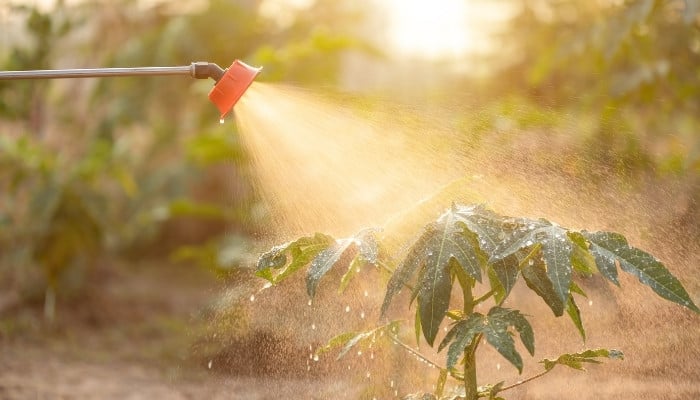If your plants are not receiving enough nutrients despite having fertilized soil or growing medium, it is possible that low nutrient uptake is the issue.
On the other hand, it could be that the soil is simply old and used up, with little to no microbial growth and low water retention.
In either case, humic acid could be the answer to your plants’ problems.
Humic acid is an excellent additive to use for plants. It improves microbial growth, yields greater water retention, and produces better soil structure in general. Humic acid also decreases toxin levels in soil and improves the nutrient absorption rate of plants.
Read on below for an in-depth breakdown of just exactly what humic acid really is, why it’s good, and how to use it for your plants.
Humic Acid: Definition, Benefits & When To Use It
Humic acid, by definition, is a group of binding molecules that improve plant roots’ ability to receive and absorb water.
In reality, humic acid is good for more than just improving water absorption; it also increases crop yields, prevents disease, and increases the overall health of your plants.
Additional benefits of humic acid include increasing the nutrient absorption rate of plants, creating higher water retention, improving microbial growth, and aiding overall better soil structure.
Humic acid also decreases toxins and other harmful contaminants in the soil.
You should use humic soil once or twice a year, typically in the spring and fall.
That way you know that your plants are actually able to uptake the nutrients and water you provide for them, and you’ll note an increase of their health and yield in general.
What Does Humic Acid Contain?
Humic acid comes from leonardite shale, one of the most concentrated organic materials that exist. Its makeup is one of several closely related and complex macromolecules.
The mass of humic acid consists of around 50% carbon, 40% oxygen, 5% hydrogen, 3% nitrogen, and less than 1% sulfur and phosphorous.
The youngest material found in humic acid ranges in size from 1,000 daltons (a unit used to measure the mass of atoms) to even less.
On the other hand, the oldest parts of humic acid’s mass measure up to 100,000 daltons and more.
Benefits of Humic Acid
The most significant benefits of humic acid include five different areas: biological, chemical, physical, economic, and ecological.
We discuss these benefits of humic acid in detail below.
Biological Benefits
The biological benefits of humic acid on plants come from the stimulation of micro-organisms.
When used on plants, humic acid increases the growth and propagation of cells, raises production rates of enzymes, and improves resistance levels to pesticides and disease.
Humic acid also provides plants with thicker cell walls, better yields, bigger fruits, and healthy root systems.
Furthermore, it ensures plants are able to uptake as much food and water as they need to thrive.
Chemical Benefits
Chemically, humic acid changes the properties of soil. It neutralizes alkaline and acidic soil, balances its pH level, and generally improves its health.
Humic acid also helps plants hold more water for longer periods.
Another major chemical benefit of humic acid is that it reduces toxins and harmful compounds in soil.
Also, it helps the plant absorb more nitrogen and grow larger and healthier roots.
Physical Benefits
The physical benefits of using humic acid for plants growing in soil include better soil structure, higher water retention, and healthier root zones.
Even the physical color of soil is changed when using humic acid.
When used in hard and compact soil, humic acid loosens it. That way when the soil is watered the roots will have better access to both water and air.
It also makes the soil generally easier to work with. Humic acid can also make your lawn healthier and greener.
Economic Benefits
Economically speaking, humic acid is incredibly beneficial. It helps to produce yield increases of up to 70%. The material also reduces your need for additional fertilizer by 1/3.
Money-wise, it saves you from needing to buy new soil as often, as well as fertilizer and other nutrients.
Not to mention that it saves you money on your water bill throughout the gardening seasons as well.
Ecological Benefits
Using humic acid also benefits the local environment. It helps fight soil erosion, lowers the amount of nitrate leaching, and optimizes the efficiency of nutrients in the soil.
High salt contents and ammonia from fertilizers are also lowered by using humic acid.
Other ecological benefits include less chance for root rot and less water contamination by pesticides and other contaminants.
Is Humic Acid Safe for Plants?
Humic acid is not just safe for plants, it is amazing for use with plants.
It improves microbial growth in soil, boosts root growth, and helps plants absorb more nutrients, to say the least. It also works for balancing the pH level of the soil.
When To Apply Humic Acid
Humic acid is best applied when preparing the soil for gardening or to use in potted plants. You should also use humic acid as a soil amendment when transplanting seedlings.
Spring and autumn are generally the best times of the year to apply humic acid to soil and pots.
The best time of day to apply humic acid is in the early morning or in the evening when there is the least amount of direct sun possible.
How Often To Use Humic Acid
Humic acid doesn’t need to be applied very often. One to two times per year does it.
The only time you may need to use humic acid after treating your soil in the spring and autumn is if you’re transplanting plants into the ground or pots.
Does Humic Acid Affect Soil pH?
Humic acid improves the pH level in alkaline and acidic soil. In soil with higher pH levels, humic acid works as a buffering agent to lower levels.
Soil with high levels of organic matter and clay soils are only slightly affected pH-wise.
How To Use Humic Acid

Humic acid is easy to use, as it is mainly applied to soil and plants in spray form. Simply follow the instructions for your sprayer, add humic acid, and mix a tank full.
Spray the humic acid directly to the top of the soil as well as the bottoms and undersides of leaves on your plants.
Humic Acid Applications
Humic acid is highly beneficial in far more applications than just for plants and soil.
It is also a main ingredient in sealants, mastics, asphalt-based products, and other construction-grade compounds.
Additionally, humic acid is used in some medicines for treating viral infections, including the common flu, bird flu, and swine flu.
Humic acids can be used in modifying asphalt-based products such as roofing compounds, mastics, sealants, coatings, etc.
Due to their dispersant characteristics, they have the potential of improving the loading of inert solids.
Can Humic Acid Be Used for Lawns?
As a soil amendment for lawns, humic acid is an excellent choice. It not only improves general soil structure in sandy, clay, and compacted yards alike, but it makes grass greener as well.
That’s because it stimulates microbes as well as improves the plants’ water and nutrient uptake.
Can Humic Acid Be Used During Flowering?
Humic acid can be used during flowering as a means to provide concentrated dosages of all the essential nutrients plants need during flower cycles, including micronutrients and vitamins.
Humic Acid Good for Potted Plants?
For potted plants, humic acid helps increase the health of the soil, accelerate root growth, and prevent general wilting due to lack of water.
Basically, it helps improve the soil and makes it easier for your potted plant to intake all the stuff it needs to flourish.
Can I Apply Too Much Humic Acid?
You can apply too much humic acid only in the sense that you may waste some.
Applying more humic acid than your soil or plants need doesn’t harm them. The plants simply take what they need, and the rest goes to waste.
Related Question:
Which Is Better – Humic Acid or Fulvic Acid?
Humic acid and fulvic acid are both good, but your plants’ situation decides which is better to use at the moment.
Humic acid helps improve overall soil structure and plant growth, whereas fulvic acid is strictly used for helping increase your plant’s water uptake.
Is Humic Acid Right for Your Plants?
Humic acid is an extremely helpful little gardening hack to know about.
If you use it correctly, you’ll keep your soil and plants in good shape due to better soil health and water and nutrient absorption.

